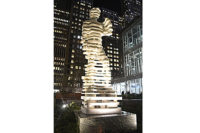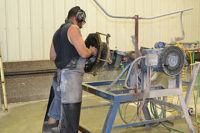“I invented the machine back in 2006, and it was totally by accident,” Tesh explained. “I had been semi-retired as a commercial photographer, and a colleague of mine started a granite countertop company. I wanted to make a faucet hole punch, so fabricators could use it in the shop instead of drilling holes on site. When we were testing it, we were getting perfect stone hockey pucks, but broken slabs of granite. So then I started thinking another way. When I visited my friend’s shop, I saw a container full of scrap stone. He told me that he spent $1,200 a month to haul it off. We then did a hand press and popped out a perfect 3- x 6-inch piece from scrap stone. It was done by Newman * Whitney right here in Greensboro. There is a metallurgy of how to make these dies that could take this incredible punishment. We hired a metallurgist to make the dies, and we received a worldwide patent.”
EarthStone Products was formed in 2007, and it operates five StoneCycler units to turn scrap stone into reclaimed stone products for a broad variety of applications. “By starting EarthStone Products, we learned what the machine could do and what it could not do,” Tesh said. “I am compressing the learning cycle of others by two years. It’s great to see what other ideas fabricators come up with for this technology. GranQuartz has played a big part in this and has been our industry partner since day one. With their nationwide sales and service, they can handle anything our customer needs.”
Processing and selling reclaimed stone
With the five StoneCyclers in place, EarthStone Products is offering a range of architectural products, including backsplashes, pavers, interior flooring, fire pits and more. “We started off using it as a backsplash machine, but the average backsplash is 35 feet, and the average paving job is 300 feet, so we really got into the paving,” Tesh said. “It has really taken off, especially in the last six months since the economy has started to come back.”
At EarthStone Products’ facility in Greensboro, material movement is carefully coordinated. “Each machine is operated by one man. We have two machines sitting face to face, and two workers standing back to back from each other with a single 3-foot-wide roller conveyor in between them,” Tesh said. “Another worker is feeding scrap down the conveyor. He may also be breaking pieces into more manageable pieces so we don’t get as much waste. Another guy moves waste containers and loads pallets. They get into quite a rhythm, and there is no lost motion. We always have two guys that are doing two different sizes — one smaller and one larger. There are two machines that are always going eight hours per day, five days per week. In the spring, we may double and triple production.”
The production rate varies, based on the finished product. “It all depends on the size you’re cutting,” Tesh said. “The machine presses three pieces per minute. If we are doing 3- x 6-inch pieces, there are 800 pieces in 100 square feet of scrap. If we are doing 6- x 9-inch pieces, there are 260 pieces in 100 square feet. We are picking up scrap from every granite fabricator within 50 miles of us, and we reclaim 200 tons of material per month. We do generate some waste, which goes in a 20-yard container. That waste goes into what they call a ‘beneficial landfill’ and gets crushed into gravel at no charge to us.”
Also speeding production, Tesh has developed a “double die” that can process two finished pieces at a time. “If you take a piece of material at least 12 ½ inches wide and 9 ½ inches deep, and you can produce two 6- x 9-inch pieces at once, you are getting six pieces per minute.”
“ We started off using it as a backsplash machine, but the average backsplash is 35 feet, and the average paving job is 300 feet, so we really got into the paving,”
John Tesh of EarthStone Products, Inc.
In addition to the shop, EarthStone Products also has workers in the field. “We’ve gotten into the install business with our paving,” Tesh said. “We do it as an overlay over a patio or sidewalk. Generally, you have two sides of a patio up against the house, and two sides where the concrete stops. The only place where something needs to be adhered is where the concrete ends. You place caulk down on edges, and then you do a solider course on the outside to create the outside edge, and that becomes the dam.
So you start on the outside and work your way in. All of the cuts needed would then go against the house, but if you fit all of the pieces right, you can make the adjustments that you need so you won’t have to make cuts. Everything is loose laid and straightened, and then the polymer sand locks it all together. We add polymer sand into the joints and broom in and broom out, and then activate it with water. The only tools you need on the site are a broom, a string line, a 90-degree angle grinder with a diamond blade and a nail puller.”
In general, the paving jobs use the underside of the scrap material on the surface. “We treat the back side with a high-pressure pressure washing system, and the surface is almost sandblasted,” Tesh said. “That cleans it, and gives it a nice texture.”
Additionally, the company is using the StoneCycler units to produce stone for fire pits. “The fire pit die has been a great thing for us,” Tesh said. “We are selling them at home and garden supply retailers, Ace hardware stores and more. We were recently at a home show, and had orders for 42 of them.”
Tesh explained that a typical fire pit has 90 pieces. “One machine can do about two fire pits per hour,” he said. “Each machine stamps out three pieces per minute, so if you’re selling the pits for $99, you’re making $3 per minute — or $1 per ‘pop.’ About 95% of the fire pits are a mixed blend — with light and dark pieces.”
Project types
EarthStone Products’ stock production is sold in stone yards and masonry yards. “We sell to retailers that offer boulders, flagstone, Bluestone and concrete pavers,” Tesh said. “Those places become our dealers. They have the customers — landscape architects and architects — that would want a green product that is also four times as strong as a concrete paver.”
A notable attraction for architects is that the North Carolina Department of Environment and Natural Resources certified EarthStone Products as a “granite recycling center.”
“We have been specified in state and federal governmental projects, hospitals, schools, libraries and parks,” Tesh said. “We supplied 5,000 square feet of pavers for a catholic church parking lot, and that has to be one of the nicest parking lots I’ve seen. We are also doing several branches for Panera Bread — creating an exterior outdoor dining area. It is part of their overall green story. When we met with them, we did an 18- x 20-foot patio in their alleyway in three hours, and they were blown away.”
Among the more noteworthy completed projects, EarthStone Products supplied material for two separate projects for the North Carolina Department of Environment and Natural Resources (NCDENR).
The patio space at NCDENR features 5,000 square feet of reclaimed granite, and it received LEED Gold certification. Meanwhile, the entrance area at NCDENR features 1,000 square feet of reclaimed granite, and it received LEED Platinum certification. “We visited with the architects at O’Brien/Atkins, and we ended up doing custom pavers in the shape of the state of North Carolina for the entrance,” Tesh said. “We are also using that shape for highway rest stops for the North Carolina Department of Transportation.”
Among the accolades received by EarthStone Products, it was named one of the “Editors’ Top 12 Picks” for 2011 by McGraw-Hill’s SNAP Magazine. Additionally, Building Green Magazine named EarthStone’s production as a “Top Ten Product of the Year” in 2010.















